Panasonic S1R Review
Panasonic S1R Review
A serious new mirrorless contender for pro photographers...
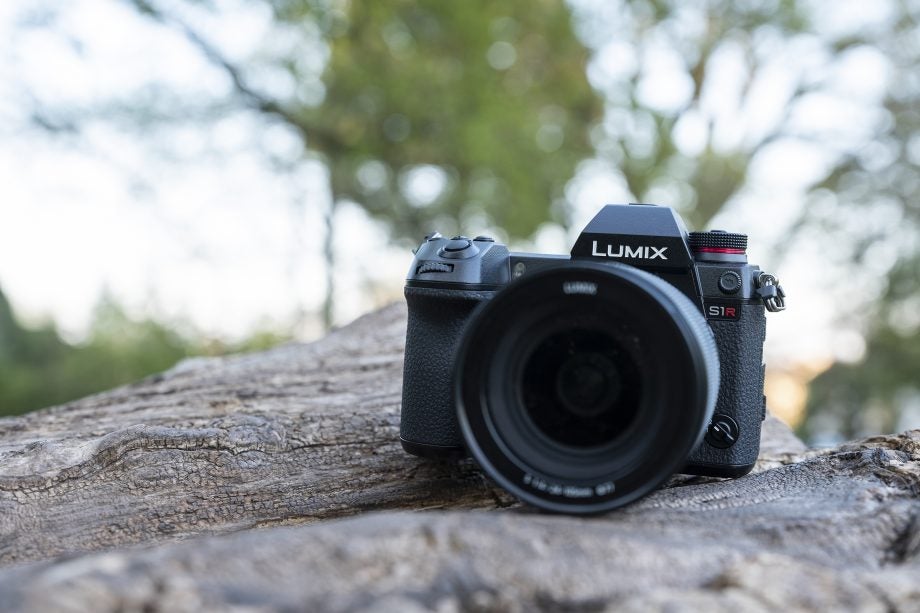
Verdict
An extremely capable full-frame mirrorless camera – if you're a pro who likes larger bodies, dual card slots and features like 6K Photo, then the S1R is a strong alternative to high-res rivals from Nikon and Sony. Its lens collection is far from fully developed, though, and anyone looking for a small and light mirrorless camera should look elsewhere.
Pros
- High resolution sensor produces great results
- Superb electronic viewfinder
- Handy unique features like 6K photo
- Tr-axial tilting touchscreen
Cons
- Larger and heavier than rivals
- Not great for action
- Limited battery life
- Lens options quite limited (for now)
Key Specifications
- Review Price: £3399.99
- 47.3MP full-frame sensor
- 5.76-million-dot electronic viewfinder
- 6-stop Dual Image Stabilisation for stills and video
- High Resolution Mode produces 187MP images
- Shoots 4K/60p video (with 1.09x crop)
- Compatible with L-Mount lenses
What is the Panasonic S1R?
Ten years after Panasonic pioneered mirrorless cameras with its first Micro Four Thirds model, it’s finally succumbed to the pressure of making a full-frame equivalent for pro photographers.
In fact, it’s made two new cameras, aimed at very different people. The Panasonic S1 is the cheaper, lower resolution hybrid model for those whose photographic diet is a mix of video and stills.
But for single-minded, professional stills shooters, there’s the 47.3-megapixel Panasonic S1R. This is the highest resolution full-frame camera so far and is packed to the gills with features that feel like glossy brochure advertising the powers of mirrorless.
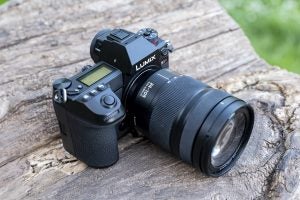
This is a big turnaround from the full-frame options available in 2018. This time last year, Sony had the full-frame mirrorless market all but sewn up. Fast forward a few months, and Sony has hot competition from Nikon, Canon and, now, Panasonic.
Importantly, the S1 and the S1R are part of the newly formed ‘L Mount Alliance’ between Panasonic, Leica and Sigma. That means that while native Panasonic lenses for now are scant, these cameras accept other L Mount optics from Leica’s existing range and, in the near future, new Sigma glass too.
Unlike those other mainstream manufacturers, it could be argued that Panasonic doesn’t quite have the same appeal for professional photographers. It has always been popular with pro videographers, but its cameras have always been more geared towards enthusiast stills shooters.
With the Panasonic S1R, that’s all changed, and in pretty emphatic fashion too…
Related: Best mirrorless cameras
Panasonic S1R – Design and Features
There is, quite literally, no getting around it – the S1R is big. Some will love that, some will hate it.
When mirrorless cameras were first revealed, their small size was one of their big advantages over DSLRs. While that may no longer be quite the case, the size of the Panasonic S1R won’t be to everyone’s taste. Still, if you don’t like the small bodies of the Sony and Nikon range, at least you now have a choice.
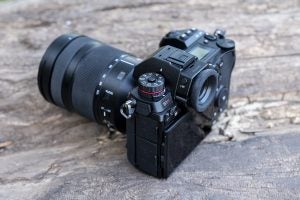
One positive of having such a large body is the number of dials and buttons it can comfortably accommodate, as well as the chunky grip that sits well with anyone who has larger hands. With weatherproofing and a solid build quality, this is a camera that feels like it could withstand some serious damage, or indeed the working life of the average pro.
The S1R is very much like a larger, chunkier Panasonic G9 or Panasonic GH5. It has a very similar layout and control system, so if you’re coming from one of those cameras you’ll feel very at home here. If you’re brand new to Panasonic’s way of doing things, it’s pretty logical to get used to in the main.
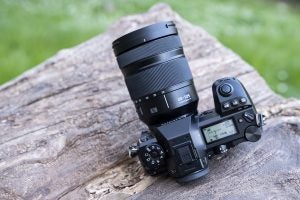
On the top plate there’s a lockable mode dial for moving between the various exposure options available. It sits on top of a smaller dial for switching between drive modes. Also found on the top plate is a secondary screen, which displays all your key settings at a glance, such as aperture, shutter speed, remaining battery and card space. There are also dedicated buttons for white balance, ISO and exposure compensation.
A small, but significant, complaint here is the position of the on/off switch. It’s ever so slightly awkwardly placed, but you do get used to it with time.
Moving to the back of the camera, and you’ll find the bulk of buttons and dials grouped on the right hand side of the body. Some buttons of note include a Q button for quickly accessing oft-used settings, which can be customised. There’s also a small dial for choosing different focusing modes, with a button in the middle of it for selecting further different focusing options.
A dual dial system at the front and rear of the grip is used for adjusting settings depending on the shooting mode you’re in, such as aperture or shutter speed. All in all, it’s a very sensibly arranged body layout, being similar to Panasonic’s G series cameras, and not a million miles away from any DSLRs you might have used.
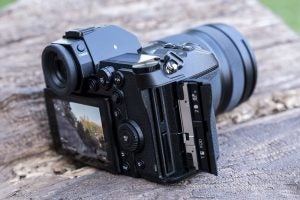
One area where the S1R has a one-up against the Nikon Z7 is the inclusion of dual memory card slots. There’s one SD card (UHS-II) and one XQD here. The newer XQD format is faster and more robust, but they come at a price premium. With more cameras on the market now carrying XQD card slots, the price point may drop in the coming future, so holding off until that happens is possible while you continue to use any existing SD cards you have.
As we’ve seen in G series cameras, Panasonic gives you a lot of bonus software features. For example, 4K Photo lets you extract stills from 4K video clips at 30fps. With the S1R, just like we’ve seen with the Panasonic G9, there’s 6K Photo, which gives you higher resolution extracted stills than 4K Photo.
You can also extract smaller stills when shooting at 60fps, for even more flexibility. This helps to make up a little for the fact that, in terms of action photography, the S1R’s offering is a little lacklustre – you get 9fps if you’re prepared to fix focus on the first frame, or 6fps if you want the camera to refocus in between shots.
Another interesting feature is High Resolution mode, which shoots a series of eight images with slight shifts to the sensor, merging them together to create ultra detailed images. In this case, that’s 187 megapixels, but it is limited to subjects which stay still, and requires mounting the camera on a tripod. Still, for certain types of subject, such as landscape, product and still-life photography, it could be very useful indeed.
One final bonus is that n-body stabilisation is included with the S1R, giving it up to 5.5-stops of compensation. It can also be used in conjunction with Panasonic’s new stabilised lenses for up to six stops.
Related: Best cameras
Panasonic S1R – Screen and Viewfinder
The S1R’s EVF is the best one we’ve ever seen and is a real joy to use.
At 5760k-dots, it’s the world’s highest resolution ‘finder and will convince even the most ardent EVF sceptic. It’s large, incredibly detailed, seems to suffer from no noticeable lag and is bright, too.
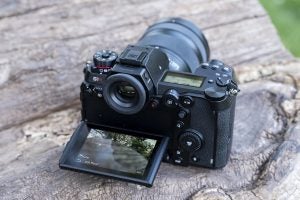
Unlike optical viewfinders, you get the advantage of being able to preview your shots exactly as they will turn out, as well as instant feedback in the form of immediate playback.
The EVF is surrounded by a large eyecup which is very comfortable to use, while there’s a sensor for automatically detecting when it’s been lifted to your eye.
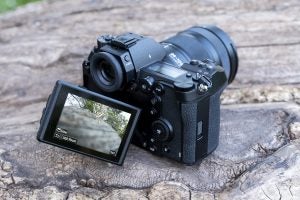
Joining the viewfinder is a touch-sensitive, high-resolution screen which uses a tri-axial tilting mechanism. That means that while it doesn’t fully articulate, it does tilt in three different directions thanks to a catch on the side of the screen.
That makes it more useful when shooting in portrait format, while removing some of the bulk of a fully articulating device. At 2,100k-dots, this is also another very high resolution device which displays the scene, and images in playback, with pinsharp clarity.
Panasonic S1R – Performance
On the whole, the S1R puts in an excellent performance when it comes to focusing. I used it with the 24-105mm f/4 S and 70-200mm f/4 S lenses, and in a range of lighting conditions, the lenses lock onto the subject with ease.
The S1R uses Panasonic’s Depth from Defocus technology, and it does a great job – along with the processing engine – in producing a very fast and responsive focusing experience.

The S1R’s Eye AF was quick and confident in our tests – if you’re further away and shooting a group of people, the focus lever lets you scroll between faces too.
There are also a few other tricks up the S1R’s sleeve. There is Eye AF, which is very adept at picking out human faces. Handily, if there’s more than one in a scene you can use the focus lever to switch to the one that should be given priority. But the system can also recognise other subjects, such as animals – this is indicated by a rectangle around the subject.
This is not a camera that I’d overwhelmingly recommend for action, sports and wildlife photography. The fastest frame rate you can expect is 9fps, dropping to 6fps if you want to refocus between each frame.

While the S1R isn’t a camera for action or sports, you can get a decent hit-rate if your subject isn’t lightning quick.
Still, if the subject is following a reasonably predictable pattern and is not moving exceptionally quickly, you can get some good results – especially if you hold down the shutter button for an extended period and hope for the best. In other words, it’s fine for the occasional burst of action, but if it’s a style you shoot particularly often in, then S1R is probably not the camera for you.
The official battery rating of the S1R is 380 shots. That’s not a particularly high figure, but it does outdo some of the other full-frame mirrorless cameras on the market, such as the Nikon Z7.
In practice, you’re likely to get much more than 380 shots from the camera, especially with careful power management (such as turning the camera off in between shots). The camera also benefits from being able to be charged with a power-bank via USB-C, so you could give it a quick boost while on the move if it’s flagging.
Panasonic S1R – Image Quality and Video
Directly from the camera, images are fantastic. JPEGs show a fantastic amount of detail, natural, vibrant colours and a good degree of dynamic range.
They have a somewhat similar ‘look’ as G series cameras have produced, but thanks to the larger sensor can produce shallower depth of field effects even when shooting at reasonably narrow apertures, such as f/4. Anyone who moves from a G series up to an S series is likely to be seriously impressed with the difference in image quality.

The S1R maintains a high level of detail with minimal noise when shooting at relatively high ISOs like ISO 6400.
That larger sensor also ensures better low light shooting than you’d get from a Four Thirds sensor. Noise is kept under control throughout the native sensitivity range, with only the top sensitivities being out of bounds for making very large prints. Detail is also well kept when shooting at high ISO settings, such as ISO 6400, with not too much evidence of smudging.
If detail is your thing, shooting in the High Resolution mode is a great option. It won’t work for every subject, but for anything that keeps still, or reasonably still, it’s worth trying out. The detail resolved using this setting is incredible, as you’d expect from 187 million pixels. It also doesn’t seem to throw up any strange artefacts as we’ve seen from similar modes on other cameras.

Shoot in JPEG and you’ll be treated to superb, natural colours and excellent dynamic range.
Automatic white balance does a good job of keeping colours natural and realistic under a wide range of different shooting conditions, including artificial light and overcast skies. On the whole, the all-purpose metering setting produces very balanced exposures too – you may find you need some exposure compensation if shooting in very high-contrast situations, but otherwise, it works well.
Image stabilisation is baked into both the camera and the lens, and they work well together effectively to help produce sharp shots when shooting handheld. You may not quite get the promised six stops, but depending on your steadiness, you can expect at least 3-4 stops in most situations.

The metering and automatic white balance perform well in most situations – only scenes with mixed lighting demand the occasional nudge of exposure compensation.
If you’re a videographer, then the Panasonic S1 is likely to be the better camera for you, but this wouldn’t be a Panasonic cameras if it didn’t offer a broad range of video tricks. On the S1R, there’s 4K video recording at up to 60p, something not seen in other full-frame mirrorless models. Other useful features include a headphone socket, microphone socket and HDMI output.
Why buy the Panasonic Lumix S1R?
The Panasonic S1R is a great new alternative option for pros who are looking for a high-resolution, full-frame mirrorless camera, but have so far been unimpressed by the limitations of other full-frame systems.
That doesn’t mean it doesn’t come without its own limitations. The L Mount Alliance means it does benefit from some existing lenses, but with many of those made by Leica, it’s not something for the budget-conscious. For example, the SL lens range are all cost north of £3,000 each when bought new.
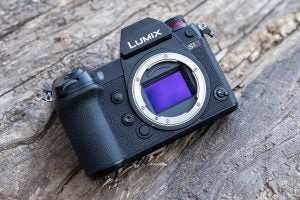
It’ll be great to see more Panasonic branded lenses arriving, but that’ll take a little while – so far, its roadmap includes its three current L Mount lenses, with five more to arrive in 2019, and another four (including two primes) slated for launch in 2020.
Another factor to consider is that the body of the S1R is big, bulky and heavy. Whether that’s necessary for a mirrorless camera is debatable, but if you’re not a fan of the smaller bodies of the Nikon and Sony systems, then you may just find the S1R appealing.
Its image quality is great too – special praise should go to the High Resolution mode, which looks like a real bonus for certain kinds of photographer. Perhaps the only weak area of concern is for action and moving subject photographers, who are probably better served by cameras like the Sony A9.
Panasonic S1R – The Rivals
Nikon Z7
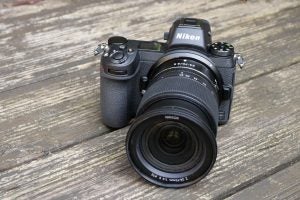
Quite possibly the best compromise between size and full-frame goodness, the Nikon Z7 distils everything we loved about the NIkon D850 and shoves it into a smaller, more portable, travel-friendly package. Lenses and accessories for Nikon’s Z range are scant for now, but you can use your existing DSLR lenses via an adapter.
Canon EOS R

Canon’s full-frame mirrorless options have been met with a little less enthusiasm than the Nikon Z range, but if you’re already embedded in the Canon system it makes a lot of sense. Again, the native lens range is pretty thin on the ground, but it seems likely more will be revealed before too long.
Trusted Score
Features
| Megapixels (Megapixel) | 47.3 |
| Image Sensor | 47.3-megapixel full-frame CMOS |
| ISO settings | 100-25600 (50-51200 extended) |
| LCD Monitor | 2100k-dot 3.2-inch triaxial tilting touch-sensitive screen |
| Video (max res/format) | 4K at 60p |
Physical Specifications
| Dimensions Width (Millimeter) | 148.9 |
| Depth (Millimeter) | 110.0 |
| Length (Millimeter) | 96.7 |
| Weight (body only) (Kilogram) | 1.016 |

